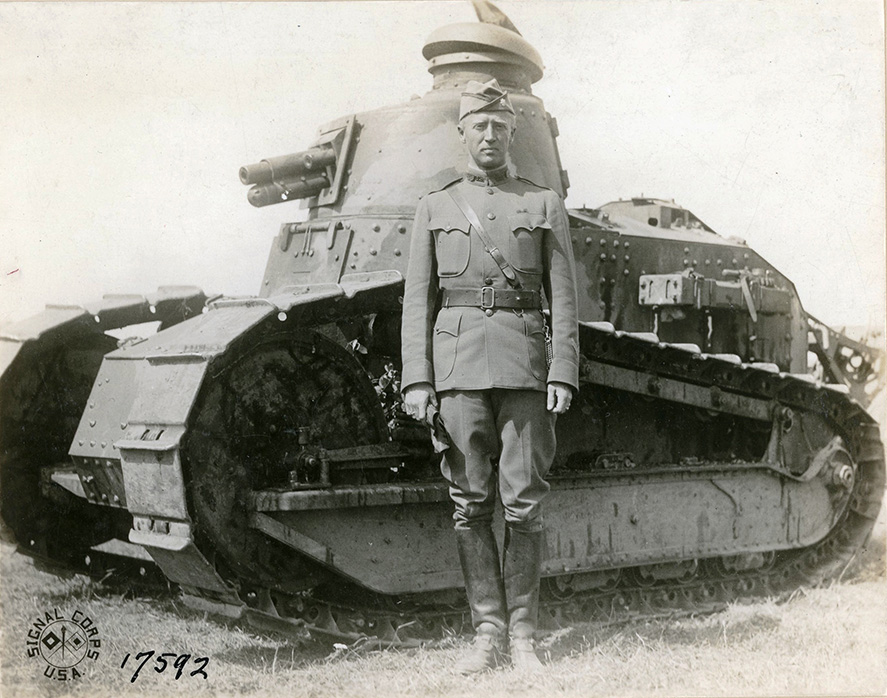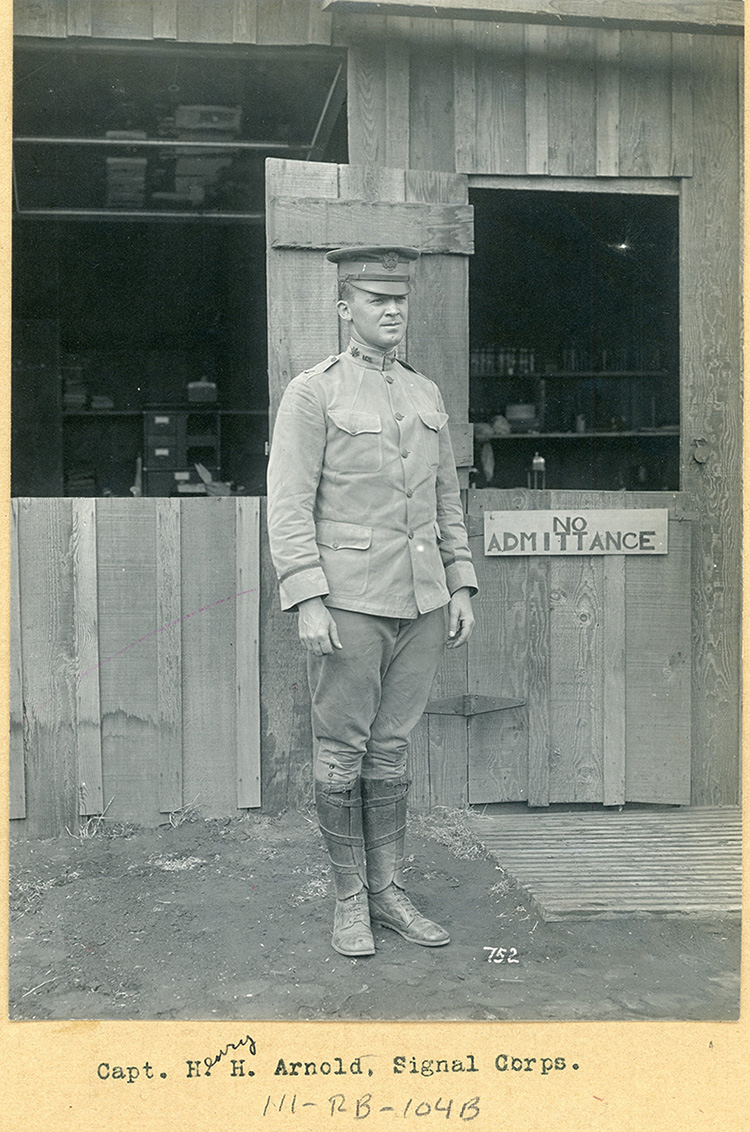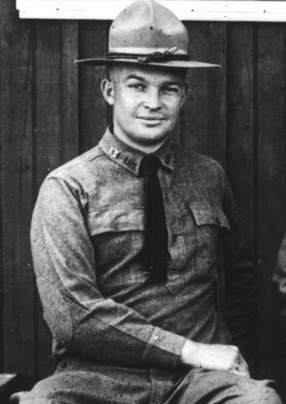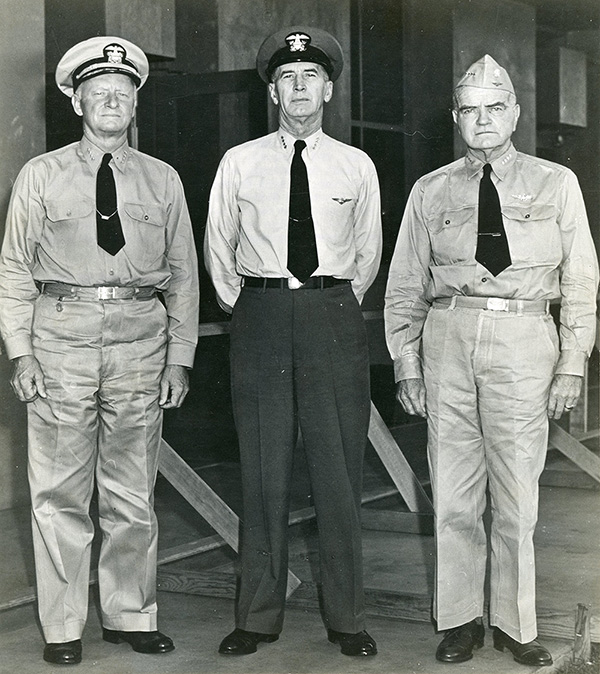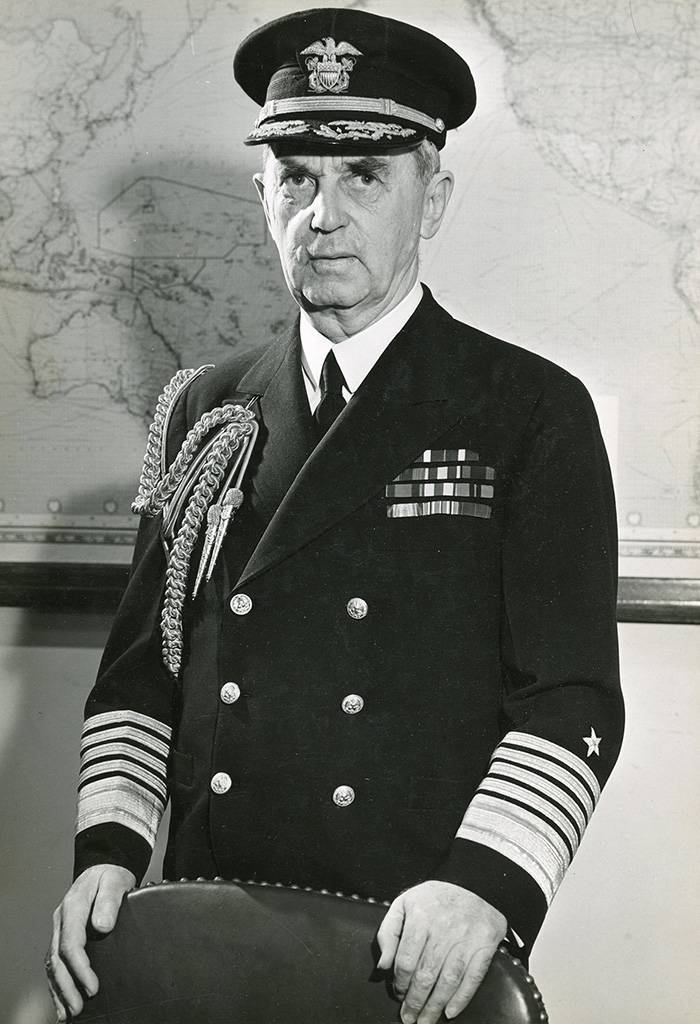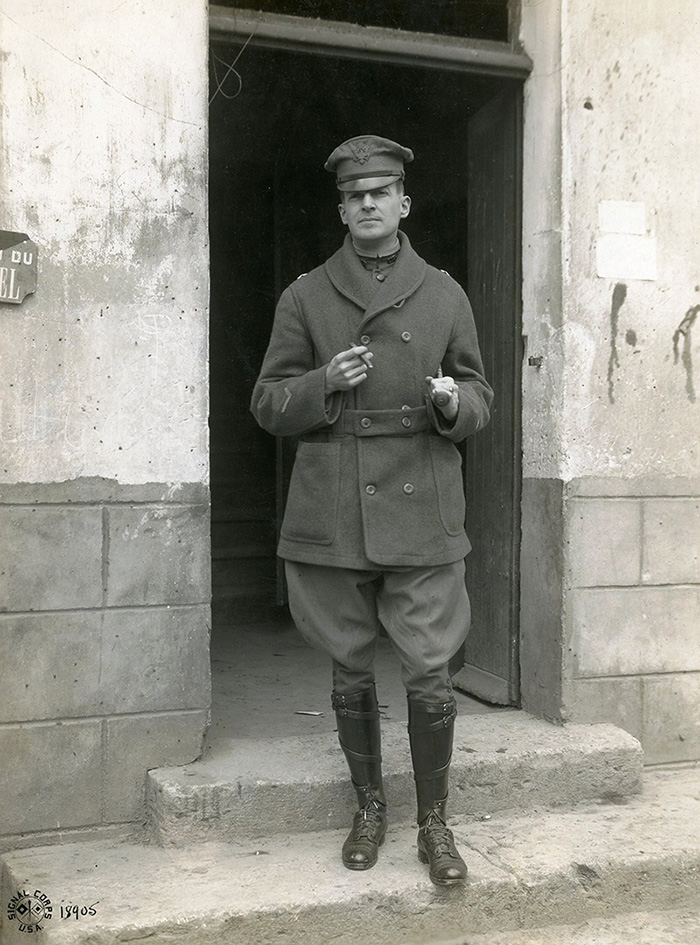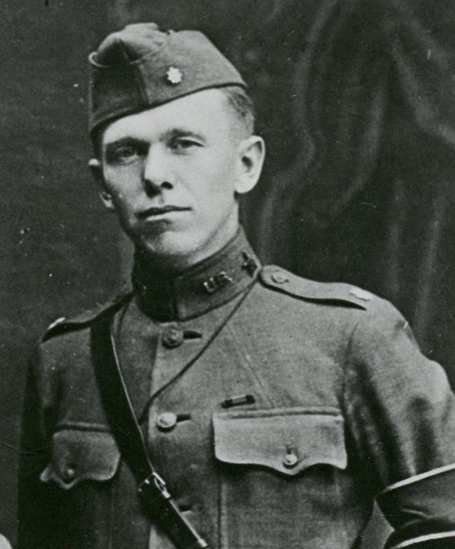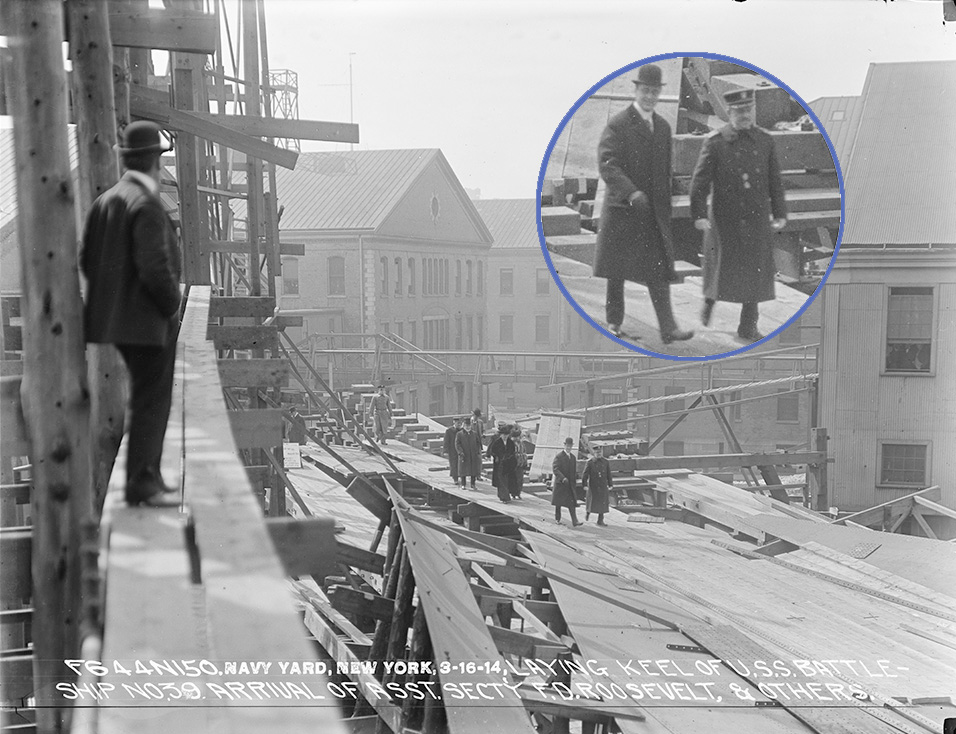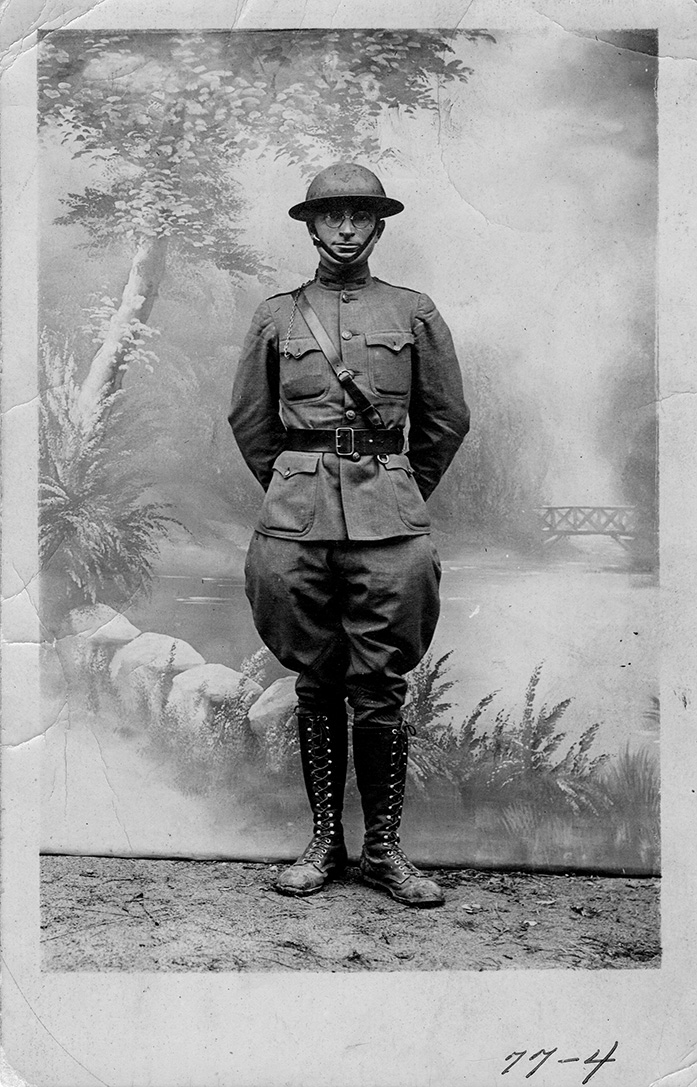
Where Our WWII Leaders Spent WWI
Summer 2017, Vol. 49, No. 2
By James Worsham
As the American forces fought the German army in a World War I battle in September 1918, the commander of a brigade of infantrymen from the 42nd “Rainbow” Division encountered the commander of a U.S. tank brigade.
The two officers, who knew of each other but had never met, stopped to chat on a French battlefield for a few minutes.
An artillery barrage burst around them, sending infantrymen diving for cover. The two officers, however, stood out in the open, talking as they prepared for their next moves.
What each one said to the other is not certain, but what is not in dispute is that this is how Brig. Gen. Douglas MacArthur and Lt. Col. George S. Patton, Jr., first met. Today, they are famous for viewing themselves as almost bullet-proof, and on that day, just a few months before World War I ended, it seemed that they were.
The troops they were commanding were moving toward the French town of Essey, as part of the battle plan for the St. Mihiel offensive.
The overall plan they were part of of had been drawn up by a young officer whose extraordinary talent at planning, organizing, and administrative work kept him chained to a desk, the combat command he wanted so badly eluding him. Lt. Col. George C. Marshall, an aide to Gen. John J. Pershing, commander of the Allied Expeditionary Force in Europe, would never lead troops in combat.
The three officers—MacArthur, Patton, and Marshall—were experiencing on a small scale in 1918 what they would be doing a quarter-century later on a much grander scale in World War II.
Then, in World War II, Patton would be drilling into Nazi-held territories with his tanks. MacArthur would be leading his troops from island to island in the Pacific toward the Japanese homeland. And Marshall would be in Washington, D.C., far from Europe or the Pacific, creating military strategy and assisting the commander in chief, President Franklin D. Roosevelt.
Other American military figures who would lead U.S. forces in World War II were also gaining valuable experience on the battlefields of Europe, the waters of the Atlantic, and on the home front in a war that was supposed to make the world, as President Woodrow Wilson put it, “safe for democracy.”
Henry “Hap” Arnold
Henry “Hap” Arnold had been interested in airplanes since he received some pilot training by the Wright brothers. During the years leading up to and during World War I, Arnold was active in promoting the military use of airplanes, and in the process he overcame his own fear of flying.
When the United States entered the war in April 1917, Arnold asked for assignment to France but was told he was needed for duty at Army headquarters, where he was overseeing the expansion of what was then known as the “air service.” His star rose, even as he ruffled some feathers along the way, and by August 1917, he became the youngest full colonel in the Army.
He continued to school himself on all aspects of military aviation—from the production of planes to the training of pilots—and learned to navigate the Washington political jungle. By the beginning of the U.S. involvement in World War II, Arnold was head of the Army Air Corps. He was promoted to General of the Army (five stars) and after the war, when the U.S. Air Force was created, given the rank General of the Air Force, making him the only person to hold five-star rank in two services.
Dwight D. Eisenhower
Dwight D. Eisenhower was a newly minted second lieutenant in 1915 and ready for combat and command when the United States joined World War I in 1917. But it was not to be.
Like George Marshall, he had shown skills at organizing and planning and never got a combat command in Europe in World War I; in fact, he never made it out of the country. He was even reprimanded for applying for overseas duty so often.
So Lieutenant Eisenhower had to settle for duty stateside. In early 1918, he took command of Camp Colt in Pennsylvania, the Army’s first training camp involving tanks. His first major problem was acquiring tanks to train with. Instead, he had the men work on internal combustion engines, while others learned telegraphy, a skill needed in Europe. To replicate riding a tank and using a machine gun or small-caliber cannons, he mounted the weapons on the back of flatbed trucks.
After a local businessman complained to his congressman about the behavior of some of the men of Camp Colt, Eisenhower told the lawmaker to go ahead: “Nothing would please me better than to be taken out of this job. I want to go overseas. If they take me out of here, maybe I can get there.” It didn’t work. Instead, he got a commendation letter for “safekeeping the welfare of his troops.”
Finally, however, he got his wish: orders to depart for France in mid-November 1918. But the war ended on November 11, 1918, and Eisenhower would stay stateside for the indefinite future.
Eisenhower would eventually get a command in Europe, and a big one—Supreme Commander, Allied Expeditionary Force, in Europe in World War II. That put him in charge of Operation Overlord, the D-day landing on the beaches of Normandy—the largest invasion in history—which succeeded in putting enough Allied troops in Europe to end the Nazis’ Third Reich within a year.
“Ike” came home a hero, a General of the Army (five stars), and eventually President of the United States.
William F. Halsey, Jr.
William F. Halsey, Jr.’s first assignment after graduating from the Naval Academy in 1904 was aboard the USS Kansas as part of the Great White Fleet. During World War I, Halsey was in the Atlantic, commanding torpedo boats and destroyers before getting command of the USS Shaw.
Most of the early part of he spent with torpedoes and torpedo boats, his specialty. Later, he would note that his career was mostly commanding destroyers and destroyer groups.
In 1934 he was offered command of the Saratoga, one of the Navy’s newest ships, on the condition that he go to flight school and be rated as an observer. He agreed, but insisted on training as a pilot, not just an observer, even though he was twice as old as the pilots then in training.In the Pacific during World War II, Halsey was given increasing responsibility for actions that would push the Japanese back to their homeland. On September 2, 1945, the Japanese signed the surrender document on the deck of his flagship, the USS Missouri. He became an Admiral of the Fleet (five stars, comparable to General of the Army) in late 1945.
Ernest King
When World War I began, King was in command of the destroyer USS Terry, which was involved with the U.S. occupation of Veracruz, Mexico, then moved over to the USS Cassin. During U.S. participation in World War I, he was on the staff of the commander in chief of the Atlantic Fleet, Vice Admiral Henry T. Mayo.
After World War I, King held several commands involving submarines and became a qualified naval aviator and chief of the Bureau of Aeronautics in the 1930s. During World War II, he became the only person to be both commander in chief, United States Fleet, and Chief of Naval Operations.
King retired after World War II, but not before he was elevated to the five-star rank of Admiral of the Fleet.
William D. Leahy
In 1915, William D. Leahy was commanding the Dolphin, a dispatch gunboat, when he became friends with the assistant secretary of the Navy, Franklin D. Roosevelt, who cruised on the ship.
In April of 1918, Leahy got command of the Princess Matoika, which was transporting American troops to France. In the period between the wars, Leahy held a variety of posts within the Navy, culminating in his tenure as Chief of Naval Operations, then retirement. As a retiree, he was governor of Puerto Rico and ambassador to France.
In World War II, President Roosevelt brought him out of retirement as the first-ever chairman of the Joint Chiefs of Staff and his own personal chief of staff. He became closer to Roosevelt and accompanied him to the Pacific Strategy Conference in Hawaii and at Yalta in 1945 with Winston Churchill and Joseph Stalin. He was promoted to Admiral of the Fleet in late 1944.
Douglas MacArthur
Douglas MacArthur had already risen to the wartime rank of brigadier general in World War I and was chief of staff to the 42nd “Rainbow” Division, which was made up of men from more than two dozen states.
MacArthur did not shrink from battle and would often be seen leading his troops while other commanders were less conspicuous. His “battlefield bravery” in Europe would earn him two Distinguished Service Crosses and seven Silver Stars.
After the war, MacArthur returned to the United States as superintendent of the U.S. Military Academy at West Point and Army chief of staff. During World War II, he was the top Army commander in the Pacific, then supreme commander in Japan; he became a General of the Army (five stars) in late 1944.
During the Korean War in the early 1950s, he openly differed with the Truman administration on policy in Korea and was relieved of all his commands in 1951 by President Harry S. Truman.
George C. Marshall
George Marshall made it to Europe during World War I as operations officer for the First Infantry Division. Although he begged for a combat assignment, he was told he was too valuable a staff officer to be sent into battle since he excelled at moving men and materiel.
Marshall would see the war from a desk, albeit not far from the battlefield. He earned high praise for his planning work in the battles of St. Mihiel, Picardy, and Cantigny.
After the war, Marshall spent five years as aide-de-camp to Pershing before his star started rising within the Army. He was assistant commandant of the infantry school at Fort Benning, Georgia, and held several other teaching and administrative jobs.
In 1936, Marshall was promoted to brigadier general after Pershing asked Roosevelt to put him on the generals list. Roosevelt became impressed with him and named him Army chief of staff in 1939 and jumped from one star to four stars as a general, passing over dozens of other generals lower in rank. In late 1944, he became a General of the Army (five stars).
He remained one of Roosevelt’s and Truman’s closest advisers throughout the remainder of the war and Truman’s term as President.
Chester W. Nimitz
During World War I, Chester W. Nimitz was busy in the Atlantic. He served as chief engineer of the Maumee, which was a refueling ship for U.S. Navy destroyers crossing the Atlantic and with which he conducted the first-ever underway refueling.
Nimitz was briefly an aide to the commander of the submarine force for the Atlantic Fleet before becoming the commander’s chief of staff.
Soon thereafter, he was assigned to the Board of Submarine Design as a senior member.
In World War II, he was commander-in-chief of the Pacific Fleet and of the Pacific Ocean areas. He was promoted to Admiral of the Fleet (five stars) in late 1944.
George S. Patton, Jr.
As a young lieutenant, George S. Patton, Jr., became interested in tank warfare and pushed it so successfully that he was assigned to establish a tank school after the United States joined the war in April 1917.
By the time World War II came around, Patton was a tank warfare expert and gained considerable ground for the Allies. Elements of his Third Army broke through enemy lines and rescued U.S. troops trapped at the Battle of the Bulge in the winter of 1944–1945.
Patton got himself into trouble at times, especially when he slapped two soldiers who suffered from battle fatigue and barely included the Russians on the list of countries that would be the major players on the world scene after the war. But when he equated Nazis in Germany to Democrats and Republicans at home, Eisenhower removed him from command of the Third Army.
Known as “Old Blood and Guts,” Patton died of injuries received in a car crash in December 1945 and is buried with his men in a cemetery in France.
Franklin D. Roosevelt
Franklin D. Roosevelt never wore a uniform and did not command men or ships, but he was President Woodrow Wilson’s assistant secretary of the Navy from 1913 to 1920.
It was a job his cousin Theodore had held on his way to becoming President, and Franklin figured it was a good route to take. As the Number 2 man in the Navy Department, he espoused policies that would raise the profile of the U.S. Navy.
He oversaw the buildup of the Navy itself, both in manpower and weaponry. He also worked with labor unions at shipyards—a job he did so well that there was not a single labor strike at a shipyard during his seven and one-half years as assistant secretary.
In 1918 Roosevelt went to Europe to check on naval installations. Although he was far from the battlefront, he was close enough for a sample. In his diary of the trip, he wrote “we passed on to the south slopes of Fort Douaumont, a quarter of a mile beyond, and sure enough the long whining whistle of a shell was followed by the dull boom and puff of smoke of the explosion at the Dead Man’s Corner we just left.”
Twenty-five years later, Roosevelt, by then using a wheelchair because of polio, would be meeting as President with Winston Churchill and Joseph Stalin at Tehran to plot their strategy to defeat Hitler’s Germany. He died just three months into his fourth term in 1945.
Harry S. Truman
While Roosevelt was the “visiting VIP” from Washington as assistant secretary of the Navy, the man who succeeded him in the presidency was much closer to the battlefront.
Harry S. Truman, who would always be “Captain Harry” to his troops, was leading an artillery company as commander of the 200-man Battery D, 129th Field Artillery, 35th Division.
Truman, whose eyesight was so bad that he memorized the eye chart so he could serve in the Army at age 33, took command of the battery after the 129th arrived at Camp Coëtquidan in Brittany in July 1918. The 129th then undertook a 100-mile march to its new location in the Argonne Forest and immediately faced five days of intense combat.
In his letters to future wife, Bess, he described what war was like. “There were some three or four weeks from September 10 to October 6 that I did nothing but march at night and shoot or sleep in daylight,” he wrote in one letter. In another, he said “I have just finished putting 1,800 shells over on the Germans in the last five hours. They don’t seem to have had enough energy to come back yet. I don’t think they will.”
As the war neared its end, the 129th was called to the battlefields of Verdun and continued to fire its last shots up until about 15 minutes before the armistice took effect on November 11, 1918.
Postscript
Although the name “Pershing” dominates the list of American commanders in World War I, the experience, however brief, gave future U.S. military leaders a real world introduction to war—on the front lines or at sea or back at headquarters.
Eisenhower, Truman, Roosevelt, Arnold, Halsey, Nimitz, MacArthur, King, Leahy, and Patton would get their turn in World War II, just a quarter century later.
Note on Sources
Much information exists on all of the leaders mentioned in this article.
This is especially true for the three men who became President of the United States. There are a number of first-rate biographies of Franklin D. Roosevelt, Harry S. Truman, and Dwight D. Eisenhower as well as recollections by Truman and Eisenhower themselves.
The author wishes to thank staff at the Roosevelt, Truman, and Eisenhower Presidential Libraries for their assistance in finding photographs of these men taken during World War I and information about their experiences during the war.
Thanks also to Rutha Beamon and Kaitlyn Crain Enriquez of the National Archives Still Pictures Branch in College Park, Maryland, for researching images of other individuals in the Army and Navy. Thanks also to the National Archives in New York City for coming up with the rare photograph of Roosevelt in 1914 at the laying of the keel of battleship No. 39, which later became the USS Arizona.
Many books have been written about the individuals mentioned here. Besides biographies of the three future Presidents, Roosevelt, Truman, and Eisenhower, there are biographies of the other admirals and generals. In addition, The Admirals by Walter R. Borneman and The Generals by Winston Groom examine the careers, and how they intersect, of Generals Marshall, MacArthur, and Patton, and Admirals Leahy, King, Nimitz, and Halsey.
Also fascinating is a paper by Kevin Hymel for the 1997 annual meeting of the Society of Military History that examines the various accounts, including what was said and wasn’t said, of the battlefield meeting of MacArthur and Patton in 1918, just a few months before the war ended.
